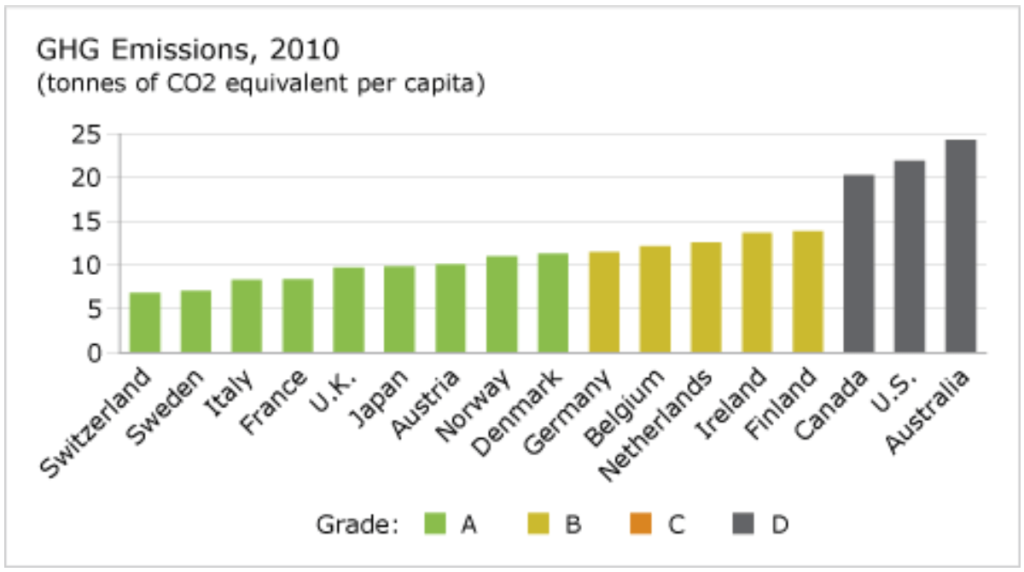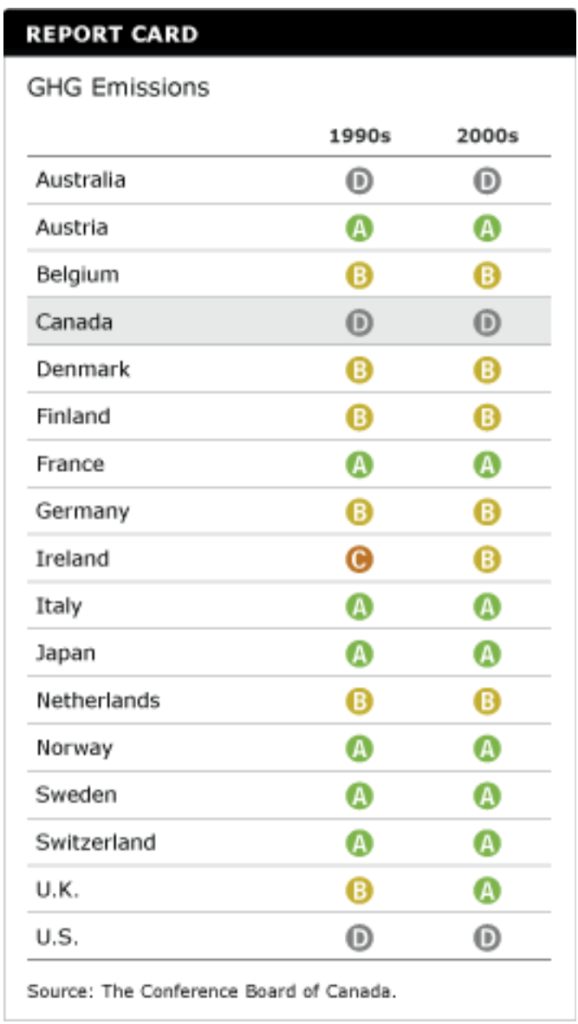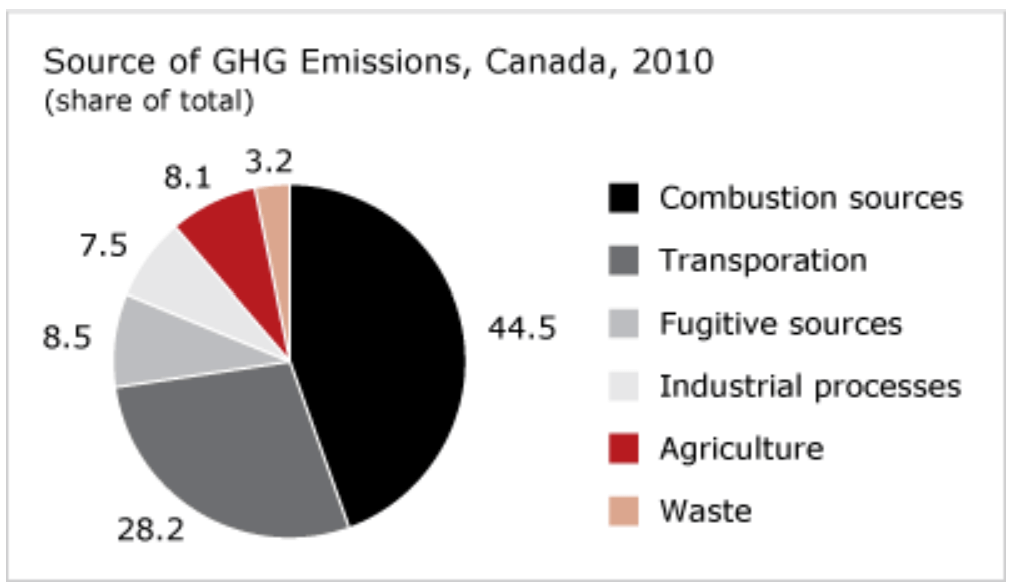GHG Emissions
Key Messages
- Canada ranks 15th out of 17 countries for greenhouse gas (GHG) emissions per capita and earns a “D” grade.
- Canada’s per capita GHG emissions decreased by nearly 5 per cent between 1990 and 2010, while total GHG emissions in Canada grew 17 per cent.
- The largest contributor to Canada’s GHG emissions is the energy sector, which includes power generation (heat and electricity), transportation, and fugitive sources.

Putting GHG emissions in context
Climate change is now the most serious global environmental threat.1 Its potential impacts include global warming, sea level rise, increased extreme weather events, and altered rainfall patterns. Climate change is a direct consequence of elevated greenhouse gas (GHG) concentrations in the atmosphere and feedback mechanisms.
Since GHGs are emitted from fossil fuel burning, energy is the key policy category for tracking and analyzing climate change. The main challenge is to make economic growth less dependent on energy use and related air emissions, by improving energy efficiency and by developing and using cleaner fuels and low-emitting electricity sources.2
How does Canada compare to its peer countries on GHG emissions?
Canada is one of the world’s largest per capita GHG emitters. Canada ranks 15th out of 17 OECD countries on GHG emissions per capita and scores a “D” grade.3 In 2010, Canada’s GHG emissions were 20.3 tonnes per capita, significantly higher than the 17-country average of 12.5 tonnes per capita. Canada’s per capita GHG emissions were nearly three times greater than Switzerland’s, the top performer.
While Canada’s GHG emissions per capita have fallen since 1990, many other countries have managed to decrease them even more. For example, Germany and the U.K. reduced their per capita GHG emissions by 27 per cent between 1990 and 2010.
Has Canada reduced GHG emissions?
Despite international commitments to drastically reduce GHGs, Canada has not seen a substantial improvement on its per capita GHG emissions. In 1992, Canada signed the United Nations Framework Convention on Climate Change (UNFCC), under which it committed to stabilizing GHG emissions at 1990 levels by 2000. In 2000, however, Canada’s absolute GHG emissions were 22 per cent higher than they had been 10 years earlier.
Canada went on to ratify the Kyoto Protocol in 2002, pledging to reduce GHG emissions to 6 per cent below 1990 levels between 2008 and 2012. As of 2010, however, absolute GHG emissions remained 17 per cent above 1990 levels.
One of the main reasons for the increase has been the growth in exports of petroleum, natural gas, and forest products. These commodities are exported, but the GHG emissions resulting from their production are not. Still, there is significant room for Canada to cut GHG emissions by increasing energy efficiency and using lower-emitting technologies.
To achieve its international commitments, Canada must make substantial GHG reductions now.
Has Canada’s relative grade on GHG emissions improved?

No. Canada was a “D” performer in both the 1990s and the 2000s. The report card in the two decades remained the same for all countries except the U.K., which moved from a “B” to a “A,” and Ireland, which moved from a “C” to a “B.”
What contributes most to greenhouse gas emissions in Canada?
The energy sector was responsible for 81 per cent of Canada’s total GHG emissions in 2010. Emissions from this sector come from combustion sources (such as electricity and heat generation, and fossil fuel industries), transportation (such as road vehicles), and fugitive sources (generated by oil and natural gas processing and, to a lesser extent, mining). Energy combustion is the largest of these sources, contributing 45 per cent of Canada’s total GHG emissions in 2010.4
Industrial processes (such as the chemical industry), the waste sector (such as solid waste disposal on land), and agriculture also generate a significant amount of GHG emissions in Canada.

What is being done to reduce greenhouse gas emissions in Canada?
The Canadian federal government recently set a new target of reducing total greenhouse gas emissions by 17 per cent from 2005 levels by 2020. To achieve this goal, it has introduced three major initiatives:
- Passenger automobile and light truck greenhouse gas emissions regulations: New emissions standards have been set for 2011–2016 model-year vehicles. The new standards are expected to reduce vehicle emissions from vehicles in these model years by 25 per cent compared with 2008 models. Over the long term, this could lead to significant reductions in annual emissions from the transport sector. The actual reduction would depend on growth in the vehicle stock, growth in kilometres traveled, and the mix of older vehicles that stay on the road after the new standards take effect. Environment Canada also intends to increase the restrictions for model years 2017 and beyond.5
- Heavy-duty vehicle emissions regulations: In April 2012, the government announced new regulations to limit greenhouse gas emissions from heavy-duty vehicles. The aim of the new regulations is to reduce emissions from these vehicles by up to 23 percent by 2018.6
- Regulations on coal-fired electricity generation: In September 2012, final regulations were revealed to reduce emissions from the generation of electricity from coal, beginning in 2015. The proposed regulations will apply stringent performance standards to coal-fired electricity generation facilities.7
All of Canada’s provincial and territorial governments have also established their own climate action plans with their own targets for reducing GHG emissions. Unfortunately, the lack of coordination among federal and provincial approaches to addressing climate change has reduced the effectiveness and efficiency of GHG reduction policies. Canadians need to get aligned—quickly—on the minimum fundamental requirements of a credible Canadian policy to fight climate change. In the view of The Conference Board of Canada, there are three basic elements to such a policy:
- being part of a comprehensive global approach
- providing clarity on attainable targets
- implementing the optimal mix of market-based policies
For a detailed analysis of the effectiveness of current federal and provincial government policies to reduce GHG emissions in Canada:
Greenhouse Gas Mitigation in Canada, Ottawa: The Conference Board of Canada, 2011.
To understand how Canada can achieve significant reductions in global greenhouse gas production while sharing fairly the economic impact of adjustment:
A Canadian Climate Change Strategy: Getting the Basics Right, Ottawa: The Conference Board of Canada, 2007.
Canada’s Energy Future: An Integrated Path, Ottawa: The Conference Board of Canada, 2007.
In a report on the use of “green taxes,” the Conference Board argues that tax measures, coupled with market forces, will be key to the fight against climate change and the ability of Canadian firms to adjust. Green taxes and green investment tax credits are needed if Canadian firms are to accelerate their technological adaptation to a carbon-priced world. As a complement to green taxes, a cap and trade system should be implemented, combining regulation with market forces via emissions trading.
Use Green Taxes and Market Instruments to Reduce Greenhouse Gas Emissions, Ottawa: The Conference Board of Canada, 2008.
Footnotes
1 Daniel C. Esty and others. Pilot 2006 Environmental Index (New Haven: Yale Center for Environmental Law & Policy, 2006).
2 OECD, Environment Directorate, OECD Key Environmental Indicators (Paris: OECD, 2004).
3 Ranking calculations exclude the offset effects of land use, land-use change, and forestry (LULUCF).
4 Environment Canada, National Inventory Report, 1990–2010: Greenhouse Gas Sources and Sinks in Canada, 2010 (Ottawa: Environment Canada, 2012) (accessed November 17, 2012).
5 Government of Canada, “Backgrounder: Key Features of Canada’s Passenger Automobile and Light Truck Greenhouse Gas Emission Regulations” (accessed June 15, 2011).
6 Government of Canada, “Canada’s Action on Climate Change” (accessed November 17, 2012).
7 Government of Canada, “Canada’s Action on Climate Change” (accessed November 17, 2012).

